NVIDIA HAS INCREASED EXPONENTIALLY in the past five years, with growth in their technology led by CEO Jensen Huang. He is driven by a passion for technologies that create a better world with efficient technologies that can help solve problems like climate change, supply chain issues, and medical research.
AI and Simulation
First off, Omniverse, NVIDIA’s simulation for creating and connecting virtual worlds, is becoming more powerful with new tools, including Omniverse Avatar, for creating digital avatars with embodied AI’s in the virtual world. The Omniverse Avatar platform allows companies to create avatars that people can interact with. This uses NVIDIA’s speech AI, computer vision, understanding of language cues with recommendations, and realistic simulation technologies.
A demonstration of a toy version of CEO Jensen Huang (part of Project Tokkio) being asked complicated questions using words and included the natural movement of the body and hand gestures people do when they communicate, creating a very natural looking avatar.
Those watching the keynote were treated to a demonstration of Project Tokkio technology, wherein a toy version of CEO Jensen Huang was being asked complicated questions using words. A natural-looking avatar (“toy me” of Huang) answered using natural body movements and hand gestures typically used by real humans.
Omniverse
Project Tokkio is a customer service kiosk with an Omniverse Maxine-powered AI talking to customers. Omniverse Replicator is a synthetic data engine that will help businesses create more accurate digital twins creating better AI tools for our world.
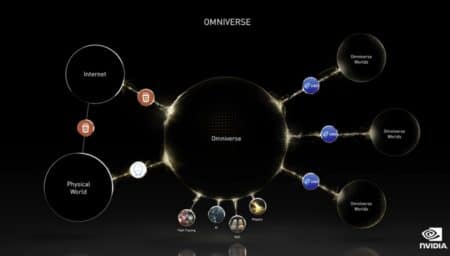
What the Omniverse looks like diagrammatically. Omniverse connects physical worlds and their data and systems with applications and their data and even other Omniverse worlds.
Omniverse Replicator has two applications. NVIDIA Drive Sim gives us a digital twin of vehicles to see how they drive in the virtual world before putting them on the road. NVIDIA Isaac Sim creates a digital twin of manipulating robots. Replicator allows companies to use this technology to learn “effective” skills in the virtual environment before being used in the real world for production or any situation.
Architects deal with many-layered complexities in creating and designing. A digital twin of a project could help solve engineering, structural, and manufacturing obstacles early in the design stage. The client can view the project in real-time and watch the progress and actively participate in the process. You can develop a virtual twin to test the limitations of a design. You can see the pitfalls before you have built something and create changes in real-time.
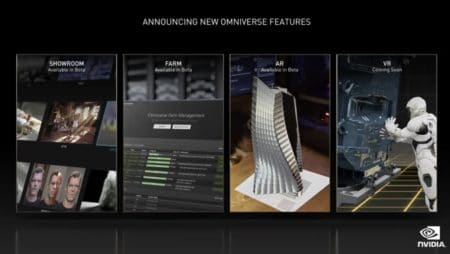
New NVIDIA Omniverse technologies or apps include Showroom, Farm, AR, and VR. These are all in beta except VR which will feature the first RTX accelerated real-time raytracing technology inside a headset.
Imagine the possibilities of Omniverse with real-time collaboration across multiple artists with the ability to access talent across the world. It gives architects flexibility without the worry of expanding their office space.
Omniverse has new features, including Showroom, Farm, AR, and VR.
Omniverse in Industry
Omniverse launched in December 2020 and has been downloaded by 70,000 people. Professionals at 700 companies are using Omniverse including gaming, CAD, medical imaging, autonomous vehicle developers, and creatives in Film & Television.
Omniverse Enterprise is available on November 9th. It allows design teams working across different software packages using the USD format to collaborate in real-time, in a shared virtual space on any device with access to global teams around the world. Huang said during his keynote that “Omniverse will revolutionize how the 43 million designers in the world collaborate.”
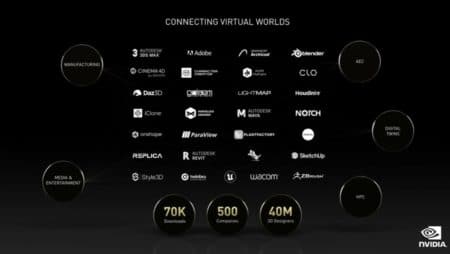
NVIDIA’s Omniverse has been popular with the industry, with thousands of companies already testing it and putting it to work.
A few Fortune 500 companies and global design leaders demonstrated their use of Omniverse including HKS Architects, KPF Architects, Ericsson, Lockheed Martin, CannonDesign, Epigraph, and Sony Pictures Animation.
CannonDesign is a global architecture, engineering, and consulting firm using Omniverse Enterprise to speed up collaborative design. Sony Pictures is using Omniverse Enterprise to enable multiple artists to work on a single scene together in real-time. Ericsson is a leading telecommunications company using the Omniverse platform to create digital twins of cities to simulate and visualize signal propagation to accelerate feature development and insights into their 5G networks.
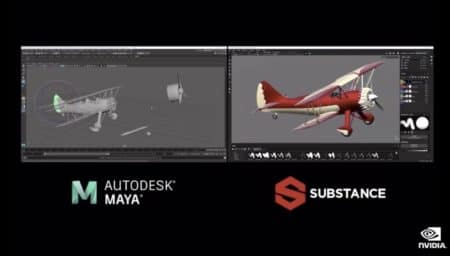
NVIDIA Omniverse will allow designers working around the globe to collaborate on 3D scenes together in real-time, each working in their own preferred software tools around their own specialization or area of interest. Noted architectural firms like KPF, HKS, and CannonDesign have all embraced Omniverse technology and are trialing solution workflows.
Bentley Systems, the infrastructure engineering software company, announced the availability of Bentley iTwin for NVIDIA Omniverse which can enable next-generation physically accurate 4D visualization and construction simulation of infrastructure digital twins for the global infrastructure engineering industry.
Bentley iTwin will allow companies to explore and visualize massive infrastructure in a virtual world like they are walking through it in real-time. Ersi, a leading urban design mapping software, is bringing Omniverse into the Ersi ArcGIS City Engine application connecting millions of ArcGIS ecosystem users to the Omniverse platform. Teams can apply full 3D city models and geographic content with photorealism, giving companies and end-users the ability to create digital twins in the virtual worlds of Omniverse.
USD at the center Omniverse
USD (Universal Scene Description) is a file format and is at the heart of Omniverse. USD was invented at Pixar and the current USD format is roughly the fourth generation of Pixar’s “composed scene description” technology.
In August of this year, Apple, NVIDIA, and Pixar joined forces to expand USD to perform physics in the Omniverse in a consistent way as the real world. In other words, simulations obey the laws of physics. Even more important, the joint work by NVIDIA, Apple, and Pixar enable the new physics extensions for USD to be flexible letting developers select which solvers to work with but all driven by the same data set of USD. Gamers prioritize speed over accuracy while architects and engineers prioritize accuracy over speed.
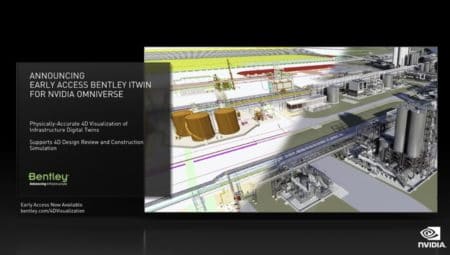
Bentley has announced its integrations with NVIDIA Omniverse with its iTwins digital twins’ technology.
Omniverse uses USD (Universal Scene Description) to create the assets inside the virtual world across many leading applications. Software companies supporting USD include Graphisoft, Autodesk, Unreal Engine, Adobe, and many more. “USD is the HTML of 3D,” stated Richard Kerris, VP of NVIDIA Omniverse. In the keynote, NVIDIA CEO Huang stated that there are 14 connectors that link apps together through Omniverse and 15 more are under development.
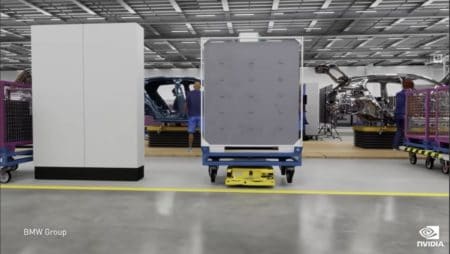
BMW is using NVIDIA Omniverse to build digital twins of factories and digital twin robots and humans and to simulate new factory designs in Omniverse before commencing with physical designs. This enables them to test out scenarios and optimize factory conditions.
NVIDIA made the announcement that there are four new features coming to Omniverse—Showroom, Farm, AR, and VR. All of them are in beta now except VR.
Omniverse is set to transform the way designers and creatives work together around the globe while enabling each designer to bring to bear on common projects their specialized skills, knowledge, and their preferred software tools, while they jointly and in real-time work on projects together literally within the same 3D environments (scenes).
next page: NVIDIA Quantum-2 Supercomputer, CUDA-X, Modulus, and Summary

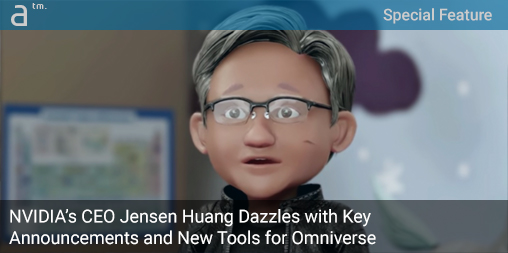


Reader Comments
Comments for this story are closed